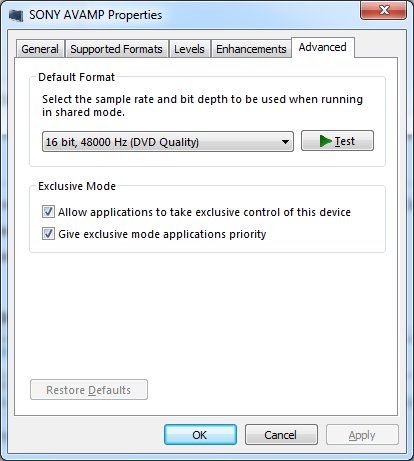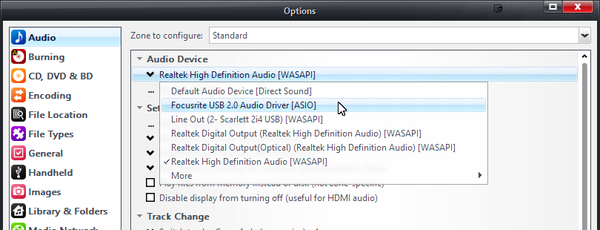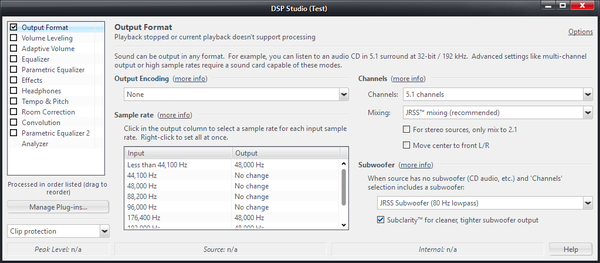Audio Setup: Difference between revisions
| Line 36: | Line 36: | ||
Open [[DSP Studio]], and click on Output Format. Make sure it's enabled by checking the box next to '''Output Format'''. |
Open [[DSP Studio]], and click on Output Format. Make sure it's enabled by checking the box next to '''Output Format'''. |
||
[[ |
[[File:MC19-DSP-Output Format.png|thumb|600px]] |
||
Then, select these settings: |
Then, select these settings: |
||
Revision as of 23:11, 7 April 2014
This guide provides an overview of how to configure audio playback in JRiver Media Center. Please follow the steps below in order.
OS Sound Support
Begin by verifying that your Operating System recognizes your sound device. If the OS cannot use the device, then Media Center will not be able to use it either.
Windows
In the Windows Sound Control Panel, play the test tones and ensure that you can hear them.
If you aren't able to get sound in Windows, you will need to solve that problem before you continue. Microsoft has a Troubleshooting Guide that may help you.
Remember the name of the sound device you use so that you can select it in Media Center.
OSX
- This article is a stub. You can help the JRiver Wiki by expanding it.
Audio Output Settings
In Media Center, select the sound device and Audio Output Mode via Tools > Options > Audio > Audio Device. You'll notice that each sound device you have available on the system may show up more than once. Select the best audio output mode for your hardware. To learn how to choose the proper mode, refer to:
If you aren't sure what to use, try the Direct Sound version first, and after you get that working well, you can explore other options.
Other Audio Options
There are a number of other Audio Options available, which are described in other sections of this Wiki. For now, it is best to leave these options at the defaults, and only change options as is required. Get audio playback working first, and then you can tweak it for optimal quality or to enable advanced features.
Output Format
Open DSP Studio, and click on Output Format. Make sure it's enabled by checking the box next to Output Format.
Then, select these settings:
Output Encoding
For most users, this should be set to None. If you have an external DAC that will do further processing, you can enable formatting options here for compatibility with your specific device.
Sample rate
You only need to configure this if you play sample rates that are not supported by your hardware. For now, leave it set to defaults.
Channels
Set the Channels selection to the number of outputs you are using from your computer. This is usually the same as the number of speakers you have attached. So for a 5.1 setup, select 5.1. For headphones, select 2 channels. For desk speakers, pick 2 or 4 channels.
Leave mixing set to JRSS v2.0 for the best quality output.
Bitdepth
In older versions of Media Center, you'd set the Bitdepth setting explicitly here. Modern versions of Media Center set this automatically. If you are still using a version of Media Center that provides this option in the DSP Studio, select the same format you used above in the OS setup (which should typically be the highest bitdepth your device supports). Learn more about Audio Bitdepth.
Subwoofer
Leave default settings for now.
Test
At this point, you should be able to play audio with Media Center. Start with simple tests like an MP3, APE, FLAC, or WAV played from a local hard drive.
If this works, move on to more complex playback like Library Server Client, DLNA, Internet radio, etc.
Troubleshooting
If your test fails, but you are able to play the test sounds via the Windows Sound Control Panel (referenced above), refer to the Audio Troubleshooting Guide for further assistance. You can also ask for help on our Interact forum.
Refining Audio Settings
Once everything is working, you can use the DSP Studio (including Room Correction) to improve the sound.
Open DSP Studio, and click on Room Correction. Make sure it's enabled by checking the box next to Room Correction.
Then, set the speaker distances for all the speakers you use.
Next, play something that uses all the speakers.
While playing, go through each speaker and tick the 'Level' checkbox at the bottom of the Room Correction page. Adjust the volume sliders until the level tones played by all speakers are the same volume. A decibel meter is best for this stage, but there are also apps that can use the microphone in your phone. You can also calibrate by ear and get passable results.
Finally, if you would like low frequencies to be routed to your subwoofer (bass management), configure the bass redirection portion of Room Correction for each speaker.


